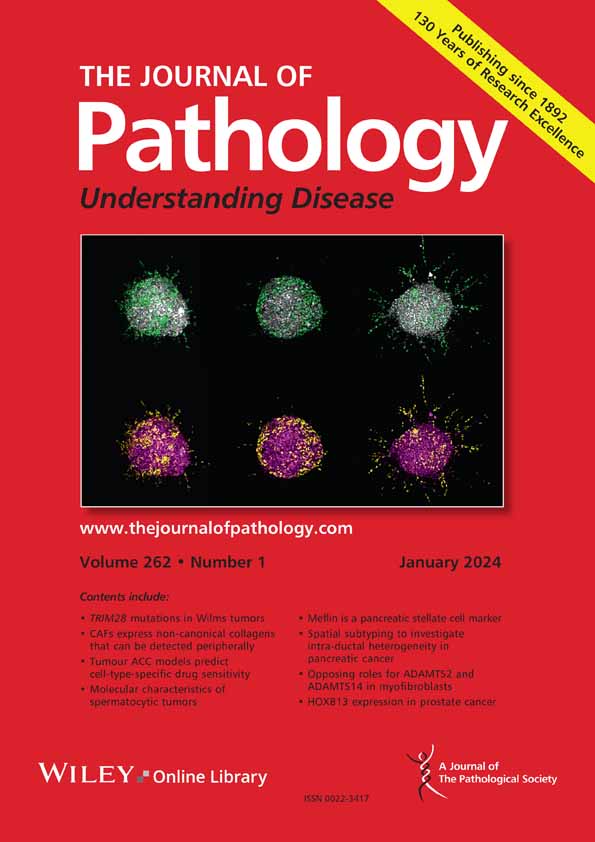Sangkyou Lee, Sung Yun Jung, Pawel Kuś, Jolanta Bondaruk, June Goo Lee, Roman Jaksik, Nagireddy Putluri, Khanh N Dinh, David Cogdell, Huiqin Chen, Yishan Wang, Jiansong Chen, Neema Navai, Colin Dinney, Cathy Mendelsohn, David McConkey, Richard R Behringer, Charles C Guo, Peng Wei, Marek Kimmel, Bogdan Czerniak
求助PDF
{"title":"线粒体能量代谢失调驱动浸润性膀胱癌粘膜场效应的进展。","authors":"Sangkyou Lee, Sung Yun Jung, Pawel Kuś, Jolanta Bondaruk, June Goo Lee, Roman Jaksik, Nagireddy Putluri, Khanh N Dinh, David Cogdell, Huiqin Chen, Yishan Wang, Jiansong Chen, Neema Navai, Colin Dinney, Cathy Mendelsohn, David McConkey, Richard R Behringer, Charles C Guo, Peng Wei, Marek Kimmel, Bogdan Czerniak","doi":"10.1002/path.6474","DOIUrl":null,"url":null,"abstract":"<p><p>Multiplatform mutational and gene expression profiling complemented with proteomic and metabolomic spatial mapping were used on the whole-organ scale to identify the molecular profile of bladder cancer evolution from field effects. Analysis of the mutational landscape identified three types of mutations, referred to as α, β, and γ. Time modeling of the mutations revealed that carcinogenesis may span 30 years and can be divided into dormant and progressive phases. The α mutations developed in the dormant phase. The progressive phase lasted 5 years and was signified by expanding β mutations, but it was driven to invasive cancer by γ mutations. The mutational landscape emerged on a background of disorganized urothelial differentiation, activated epithelial-mesenchymal transition, and enhanced immune infiltration with T-cell exhaustion. Complex dysregulation of mitochondrial energy metabolism with downregulation of oxidative phosphorylation emerged as the leading mechanism driving the progression of mucosal field effects to invasive cancer. © 2025 The Author(s). The Journal of Pathology published by John Wiley & Sons Ltd on behalf of The Pathological Society of Great Britain and Ireland.</p>","PeriodicalId":232,"journal":{"name":"The Journal of Pathology","volume":" ","pages":""},"PeriodicalIF":5.2000,"publicationDate":"2025-09-25","publicationTypes":"Journal Article","fieldsOfStudy":null,"isOpenAccess":false,"openAccessPdf":"","citationCount":"0","resultStr":"{\"title\":\"Dysregulated mitochondrial energy metabolism drives the progression of mucosal field effects to invasive bladder cancer.\",\"authors\":\"Sangkyou Lee, Sung Yun Jung, Pawel Kuś, Jolanta Bondaruk, June Goo Lee, Roman Jaksik, Nagireddy Putluri, Khanh N Dinh, David Cogdell, Huiqin Chen, Yishan Wang, Jiansong Chen, Neema Navai, Colin Dinney, Cathy Mendelsohn, David McConkey, Richard R Behringer, Charles C Guo, Peng Wei, Marek Kimmel, Bogdan Czerniak\",\"doi\":\"10.1002/path.6474\",\"DOIUrl\":null,\"url\":null,\"abstract\":\"<p><p>Multiplatform mutational and gene expression profiling complemented with proteomic and metabolomic spatial mapping were used on the whole-organ scale to identify the molecular profile of bladder cancer evolution from field effects. Analysis of the mutational landscape identified three types of mutations, referred to as α, β, and γ. Time modeling of the mutations revealed that carcinogenesis may span 30 years and can be divided into dormant and progressive phases. The α mutations developed in the dormant phase. The progressive phase lasted 5 years and was signified by expanding β mutations, but it was driven to invasive cancer by γ mutations. The mutational landscape emerged on a background of disorganized urothelial differentiation, activated epithelial-mesenchymal transition, and enhanced immune infiltration with T-cell exhaustion. Complex dysregulation of mitochondrial energy metabolism with downregulation of oxidative phosphorylation emerged as the leading mechanism driving the progression of mucosal field effects to invasive cancer. © 2025 The Author(s). The Journal of Pathology published by John Wiley & Sons Ltd on behalf of The Pathological Society of Great Britain and Ireland.</p>\",\"PeriodicalId\":232,\"journal\":{\"name\":\"The Journal of Pathology\",\"volume\":\" \",\"pages\":\"\"},\"PeriodicalIF\":5.2000,\"publicationDate\":\"2025-09-25\",\"publicationTypes\":\"Journal Article\",\"fieldsOfStudy\":null,\"isOpenAccess\":false,\"openAccessPdf\":\"\",\"citationCount\":\"0\",\"resultStr\":null,\"platform\":\"Semanticscholar\",\"paperid\":null,\"PeriodicalName\":\"The Journal of Pathology\",\"FirstCategoryId\":\"3\",\"ListUrlMain\":\"https://doi.org/10.1002/path.6474\",\"RegionNum\":2,\"RegionCategory\":\"医学\",\"ArticlePicture\":[],\"TitleCN\":null,\"AbstractTextCN\":null,\"PMCID\":null,\"EPubDate\":\"\",\"PubModel\":\"\",\"JCR\":\"Q1\",\"JCRName\":\"ONCOLOGY\",\"Score\":null,\"Total\":0}","platform":"Semanticscholar","paperid":null,"PeriodicalName":"The Journal of Pathology","FirstCategoryId":"3","ListUrlMain":"https://doi.org/10.1002/path.6474","RegionNum":2,"RegionCategory":"医学","ArticlePicture":[],"TitleCN":null,"AbstractTextCN":null,"PMCID":null,"EPubDate":"","PubModel":"","JCR":"Q1","JCRName":"ONCOLOGY","Score":null,"Total":0}
引用次数: 0
引用
批量引用

 求助内容:
求助内容: 应助结果提醒方式:
应助结果提醒方式:


